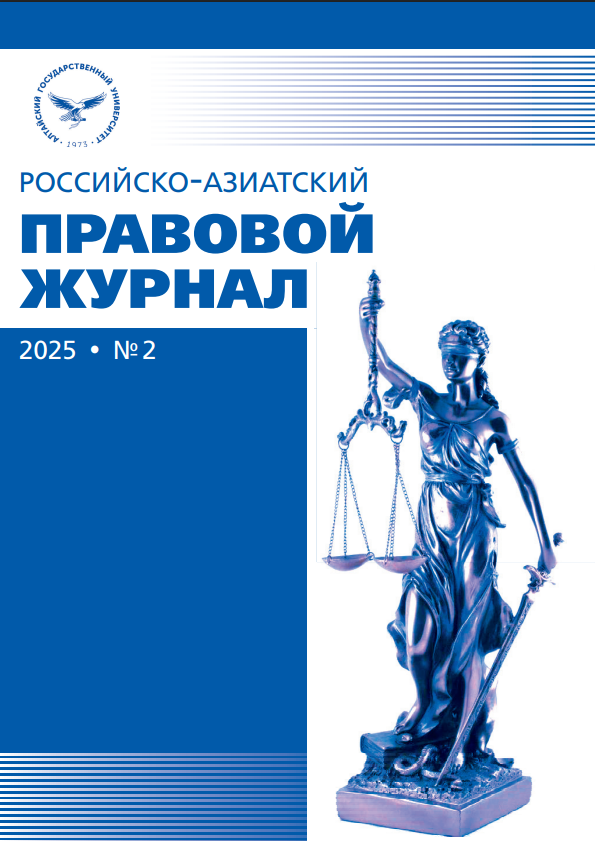PROBLEMS OF LEGAL REGULATION OF BLOCKED BUILDINGS
УДК 340:728.2 ББК 67.022.1+38.711.2
Abstract
The article considers a blockaded house as a type of residential building. The authors investigate thehistorical conditions of the emergence of blockaded houses in foreign countries, as well as analyze the reasonsfor the increased popularity of blockaded houses at the present time. The activity of homeowners aimed atthe transformation of existing residential buildings into blockaded houses is noted, which is explained by thecomfort of autonomous living and the peculiarities of the land use regime. The problematic issues that arisein the process of identifying a real estate object as a blockaded house are outlined. The paper considers themain signs of blockaded houses. In order to identify the most significant features that distinguish a blockadedhouse from other types of residential buildings, the authors compare apartment buildings and residentialbuildings. The volume and type of common property, as well as the mode of use of the land plot under thehouse, stand out as the most important features distinguishing a blockaded house from an apartment building.The problems of insufficient legal regulation of the considered sphere of legal relations under considerationare identified.
Downloads
References
2. Стародумова С.Ю. Земельный участок среди разновидностей недвижимых вещей // Гуманитарные, социально-экономические и общественные науки. 2017. №4. С. 121–125.
3. Шульпяков Г. Голландский архитектор // Огонек. Авг. 15. 2011. URL: https://www.kommersant. ru (дата обращения: 20.04.2025).
4. О внесении изменений в отдельные законодательные акты Российской Федерации: Федеральный закон от 30.12.2021 №476-ФЗ. URL: https://www.consultant.ru/document/cons_doc_LAW_405464/ (дата обращения: 20.04.2025).
5. Письмо Федеральной службы государственной регистрации кадастра и картографии от 28.03.2022 №14–2287. URL: ТГ/22https://www.consultant.ru/document/cons_doc_LAW_413445/ (дата обращения: 20.04.2025).
6. Градостроительный кодекс Российской Федерации от 29.12.2004 №190-ФЗ (ред. от 26.12.2024) (с изм. и доп., вступ. в силу с 01.03.2025). URL: https://www.consultant.ru/document/cons_doc_ LAW_51040/ (дата обращения: 25.03.2025).
7. Об утверждении Положения о признании помещения жилым помещением, жилого помещения непригодным для проживания, многоквартирного дома аварийным и подлежащим сносу или реконструкции, садового дома жилым домом и жилого дома садовым домом : Постановление Правительства РФ от 28.01.2006 №47 (ред. от 19.10.2024). URL: https://www.consultant.ru/document/cons_doc_ LAW_58136/ (дата обращения: 01.03.2025).
8. Жилищный кодекс Российской Федерации от 29.12.2004 №188-ФЗ (ред. от 03.02.2025). URL: https://www.consultant.ru/document/cons_doc_LAW_51057/ (дата обращения: 01.03.2025).
9. Решение Лесосибирского городского суда Красноярского края от 06.07.2021 №2–1446/2021. URL: https://sudact.ru/regular/doc/YtlCH5jkXddQ/ (дата обращения: 20.04.2025).
10. Решение Октябрьского районного суда города Ставрополя от 21.11.2019 № 2–29/2019 (2– 2014/2018). URL: https://soj.consultant.ru/cgi/online. cgi?req=doc&base=AOSK&n=2039116#DOASzlU WShwIZtkj1 (дата обращения: 01.04.2025).
REFERENCES
1. Volume 12. Book one. Bylinkin N.P. Architecture of the USSR. Introduction / edited by N.V. Baranov. M.: Stroyizdat, 1975. URL: https://tehne.com/event/arhivsyachina/arhitektura-zhilyh-zdaniy-sssr-1917–1932 (access date: 20.04.2025).
2. Starodumova S.Y. Land plot among the varieties of immovable things // Humanities, socio-economic and social sciences. 2017. №4. P. 121–125.
3. Shulpyakov G. Dutch architect // Ogonyok. Aug. 15. 2011. URL: https://www.kommersant.ru (access date: 20.04.2025).
4. On Amending Certain Legislative Acts of the Russian Federation: Federal Law of 30.12.2021 №476-FZ. URL: https://www.consultant.ru/document/cons_doc_LAW_405464/ (access date: 20.04.2025).
5. Letter of the Federal service of the state registration cadastre and cartography from 28.03.2022 №14– 2287. URL: TG/22https://www.consultant.ru/document/cons_doc_LAW_413445/ (access date: 20.04.2025).
6. Town-planning Code of the Russian Federation from 29.12.2004 №190-FZ (ed. from 26.12.2024) (with amendments and additions, effective from 01.03.2025). URL: https://www.consultant.ru/document/cons_ doc_LAW_51040/ (access date: 25.03.2025).
7. On Approval of the Regulations on the recognition of premises as residential premises, residential premises unfit for living, apartment building emergency and subject to demolition or reconstruction, garden house as a residential house and residential house as a garden house: Resolution of the Government of the Russian Federation from 28.01.2006 №47 (ed. from 19.10.2024). URL: https://www.consultant.ru/document/ cons_doc_LAW_58136/ (access date: 01.03.2025).
8. Housing Code of the Russian Federation from 29.12.2004 №188-FZ (ed. from 03.02.2025). URL: https://www.consultant.ru/document/cons_doc_LAW_51057/ (access date: 01.03.2025).
9. Decision of the Lesosibirsk City Court of Krasnoyarsk region from 06.07.2021 №2–1446/2021. URL: https://sudact.ru/regular/doc/YtlCH5jkXddQ/ (access date: 20.04.2025);
10. Decision of the Oktyabrsky District Court of Stavropol city from 21.11.2019 № 2–29/2019 (2–2014/2018). URL: https://soj.consultant.ru/cgi/online. cgi?req=doc&base=AOSK&n=2039116#DOASzlU WShwIZtkj1 (access date: 01.04.2025).
Copyright (c) 2025 О. Ю. Винтер, Д. В. Пятков

This work is licensed under a Creative Commons Attribution 4.0 International License.
Russian-Asian Law Journal is a golden publisher, as we allow self-archiving, but most importantly we are fully transparent about your rights.
Authors may present and discuss their findings ahead of publication: at scientific conferences, on preprint servers, in public databases, and in blogs, wikis, tweets, and other informal communication channels.
Russian-Asian Law Journal allows authors to deposit manuscripts (currently under review or those for intended submission) in non-commercial, pre-print servers such as ArXiv.
Authors who publish with this journal agree to the following terms:
- Authors retain copyright and grant the journal right of first publication with the work simultaneously licensed under a Creative Commons Attribution License that allows others to share the work with an acknowledgement of the work's authorship and initial publication in this journal.
- Authors are able to enter into separate, additional contractual arrangements for the non-exclusive distribution of the journal's published version of the work (e.g., post it to an institutional repository or publish it in a book), with an acknowledgement of its initial publication in this journal.
- Authors are permitted and encouraged to post their work online (e.g., in institutional repositories or on their website) prior to and during the submission process, as it can lead to productive exchanges, as well as earlier and greater citation of published work (See The Effect of Open Access).








